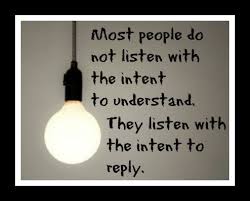A colleague and I were recently discussing the ongoing challenge of helping people learn how to communicate more efficiently with their peers, co-workers and subordinate staffing. As a company, we persistently train on positive communication, choosing words wisely, using diplomacy, exercising conflict resolution tactics….and still our leaders in management are feeling repetitive and misunderstood. Why aren’t these fundamental skills being transferred to the employee in a way that helps everyone understand each other?
Amidst the frustration-laced conversation, Colleague says, “Can you just find a non-offensive and professional way to tell people to SHUT THEIR PIE HOLE and listen first?!”
Challenge accepted.
It’s often overlooked that listening is at least 50% of the components needed for effective communication. Choice of words, tone of voice, body language and demeanor all comprise a combination of the other half. Why is listening important? Because so much of the message that is exchanged depends on how we understand what is said by the other person. But why is it so challenging just to listen?
Listening doesn’t always come easily. There is so much going on in our brains already; Generally,
- We want our side to be heard
- We’re already thinking about how we’ll respond, even while the other person’s still talking
- We tend to want to interrupt, whether due to excitement, disrespect or disagreement
- Our face wears our reactions to what’s being said, whether good or bad
- Sometimes, in an argumentative scenario, we simply want to “win”
Effective listening is an acquired skill – and we have to practice it consistently in order to make it a good habit. Listed below are NineListening Intentions that help polish our active listening skills;
1. Keep quiet while someone else is speaking. Avoiding interruption makes you a respectful conversationalist. People don’t always need to be right, sometimes they just need to feel heard.
2. Avoid distractions. Give what you expect – if you want someone to listen to you, make sure you pay it forward, give them your attention and focus on the message you’re hearing.
3. Offer unbroken eye contact. To look away portrays disinterest, apathy or indifference.
4. Nodding adds a level of engagement and acknowledges that they are being heard.
5. Tilting of the head signals interest and subconsciously shows concern in what’s being said.
6. Relax body language. Minimizing gestures and motions can avoid putting the other person on edge or in defense mode. Watch any urges to squint or roll the eyes, arch your brows or shrug shoulders.
7. Ask for clarification. If something isn’t 100% clear to you, don’t hesitate to ask for more detail. Rather than offend someone, this tactic usually shows that you care to understand. Most would rather clarify themselves than to be misunderstood.
8. Engage in repetition. Restating what you believe you’ve heard not only proves your engagement in the conversation, but also allows for the opportunity to be corrected if you’ve misunderstood.
9. Sharpen your skills with listening games, activities or exercises. Practice may not make ‘perfect’, but it certainly can make ‘better’.
Check back for a complete list of listening games and exercises for leaders, teams and staff in my next post.










